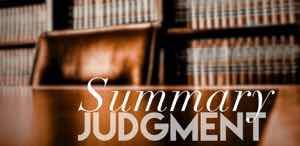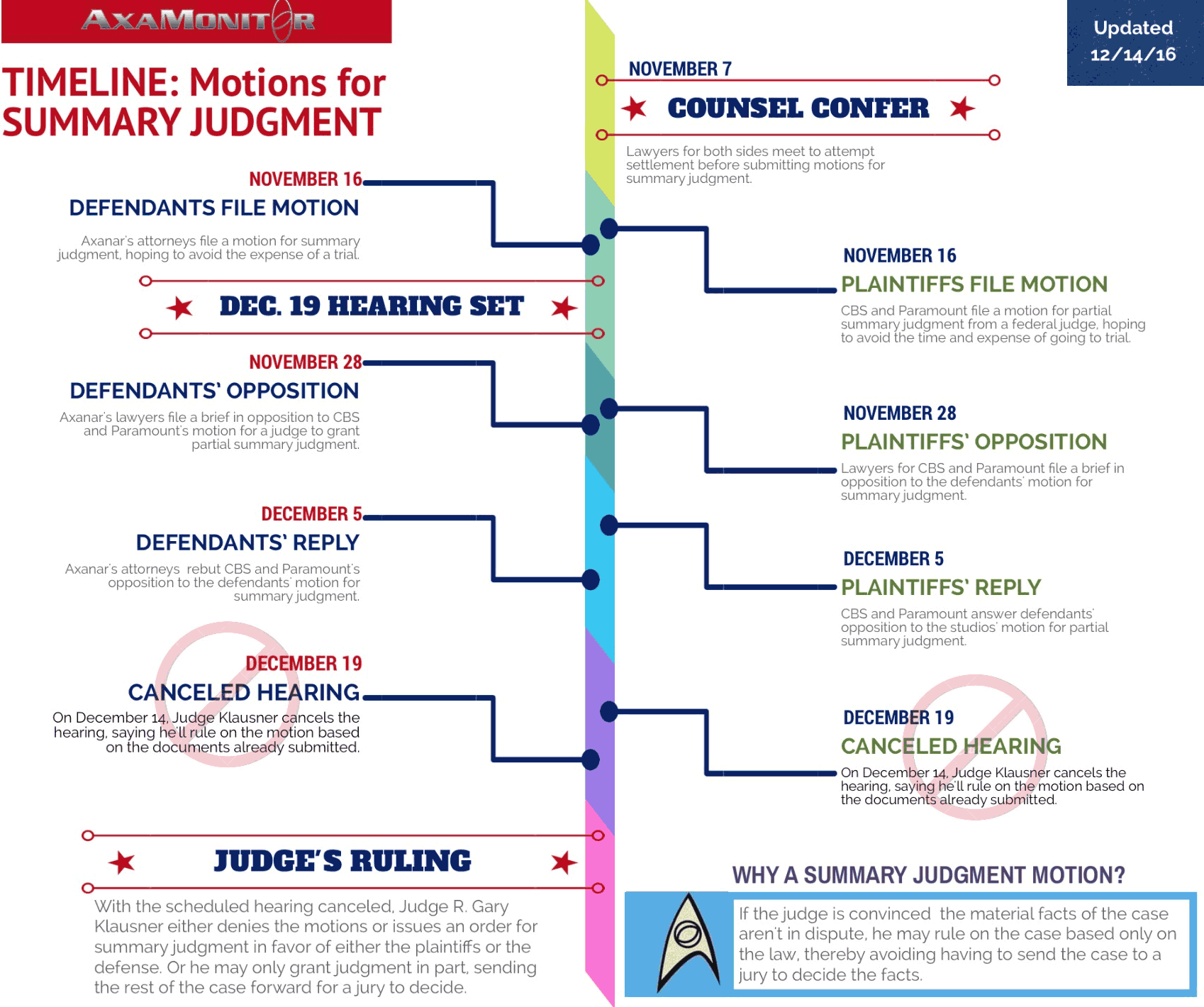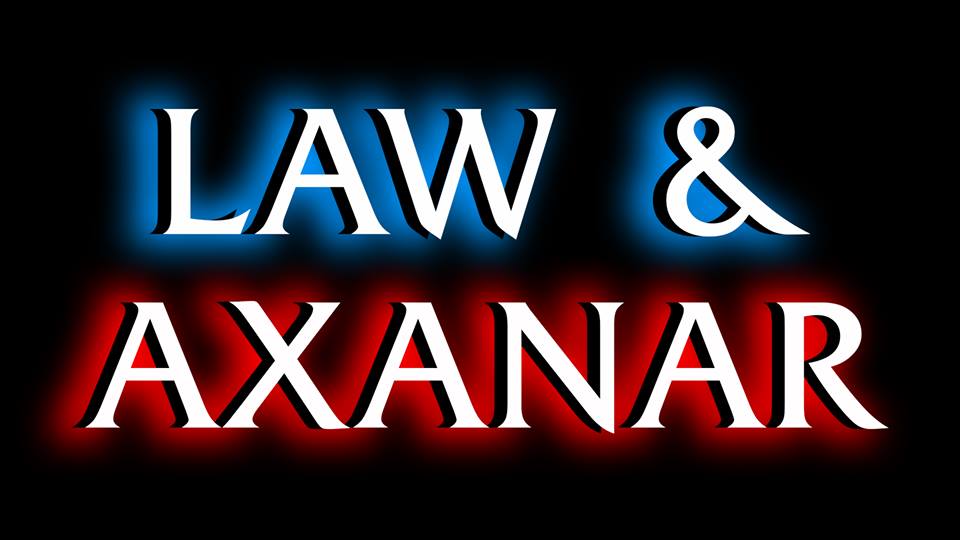Plaintiffs Cite Peters' Shocking Personal Spending in Asking Judge for Summary Judgment
Table of Contents
See also: Judge Denies Axanar Its Fair Use Defense and Explainer: Motions for Summary Judgment and Axanar Defense Also Asks Judge for Summary Judgment
In a massive filing in U.S. District Court on November 16, 2016, plaintiffs CBS and Paramount Pictures produced evidence of a shocking amount of personal spending by defendant Alec Peters from money fans had contributed to produce Axanar, who then altered financial documents to hide spending from donors.
The studios asked a federal judge to grant a partial summary judgment in the Star Trek copyright infringement lawsuit against Axanar.
The motion asked for a hearing before U.S. District Judge R. Gary Klausner on December 19 to hear arguments supporting the motion, as well as granting the plaintiffs’ request for an injunction against Axanar, including ending any kind of distribution to Peters’ Axanar works, including the already released Prelude to Axanar.1)

Earlier in the day, Axanar surrogate Jonathan Lane posted on his blog that the defense would also be filing its own motion, but the studios’ documents — including evidence such as depositions from Peters, Axanar director Robert Meyer Burnett and other staff — were posted online first by the court.
What the Motion Seeks
The plaintiffs’ motion for partial summary judgment asks Klauser to find the following facts to be undisputed:
- That CBS and Paramount own Star Treks’ copyrights; and
- Peters and his company, Axanar Productions Inc., infringed on those copyrights by “creating works that are substantially similar [to] and that copy protected elements of Plaintiffs’ works, including specific characters, settings, themes, mood, tone, plots and dialogue.”2)
Infringement Finding
The studios also sought a ruling from the judge that Peters is liable — personally, as well as in his role as sole shareholder in Axanar Productions — for contributory and vicarious infringement because he:
- Knew about the direct copyright infringement.
- Materially contributed to the infringement.
- Oversaw and controlled the infringing conduct.
- Financially benefited from the infringing acts.
Failed Fair Use Arguments
The plaintiffs’ motion also asserted that Axanar’s planned fair use defense would fail under the four-factor analysis courts apply in copyright cases.
While defense attorney Erin Ranahan has argued that Axanar’s use of Star Trek constitutes fair use, plaintiffs’ lawyer David Grossman said, “Fair use has absolutely no application to these facts and Defendants’ arguments should be rejected.”3)
Grossman applied the four-factor test under copyright law used to determine whether an otherwise infringing work is protected from liability because it is fair use.
The Copyright Act defines the term this way:
The fair use of a copyrighted work … for purposes such as criticism, comment, news reporting, teaching … scholarship, or research, is not an infringement of copyright. In determining whether the use made of a work in any particular case is a fair use the factors to be considered shall include —
1. The purpose and character of the use, including whether such use is of a commercial nature or is for nonprofit educational purposes;
2. The nature of the copyrighted work;
3. The amount and substantiality of the portion used in relation to the copyrighted work as a whole; and
4. The effect of the use upon the potential market for or value of the copyrighted work.
Purpose and Character of the Use
At the heart of Axanar’s fair use defense is the notion that its use of Star Trek is “transformative,” that is, that the manner in which the work is copied transforms it in such a way that it gains new meaning, such as that Grossman said is found in works of “criticism, commentary or scholarship of any kind.”4)
However, Grossman noted that in the defendant’s own words, Axanar was an intentional continuation of Star Trek, “true to the Star Trek canon.”:5)
Although a finding of transformative use is not required to establish the fair use defense, this factor has been described as “the soul of fair use” and unauthorized derivative works that copy creative expression and attempt to free-ride on the originality of others generally do not qualify for fair use.6)
Commercial Nature
Grossman went on to note this factor also takes into account whether the infringing work is intended for commercial or nonprofit educational purposes, despite Axanar’s unfounded protestations of nonprofit operation:
While Defendants assert that their works are not “commercial,” the evidence demonstrates otherwise.
Defendants raised, and spent, well over a million dollars from Star Trek fans. … Defendants used those funds to pay themselves, to pay actors, to pay crew members, to rent out a studio (which Peters intends to lease out for other productions), to pay tens of thousands of dollars of restaurant bills, to pay their phone bills, gas, insurance, and to travel around the country as the “producers” of Star Trek: Axanar.7)
Indeed, Peters’ company, Axanar Productions Inc. created that studio with Star Trek fans’ donations with the explicit intention “to create for-profit productions, and to continue to film unlicensed Star Trek content. … The creation of a for-profit studio intended to generate a profit for Peters is definitively a “commercial” use of Plaintiffs’ works.”8)
Nature of the Copyrighted Work
Under copyright law, the more creative a work, the greater its degree of protection from copying. Star Trek is a creatively rich universe built over a half century, Grossman said:
These highly creative works are entitled to the highest level of protection under this factor, and Defendants have appropriated all of these creative elements, for their own purposes, and without authorization.9)
Amount and Substantiality of the Portion Used
Though Peters has claimed Axanar used fewer of Star Trek’s copyrights than fan films do, Grossman pointed to Peters’ appropriation of “nearly every major element from the Star Trek Copyrighted Works. Indeed, they were required to do so in order to professionally produce [what Peters himself called] an ‘independent Star Trek film.’”10)
Among the specific and substantial elements Axanar copied were:
- The plot in the Original Series episode, “Whom Gods Destroy,” which introduced Axanar’s protagonist, Garth of Izar, portrayed by Peters himself in Prelude, and the Battle of Axanar.
- Story elements and the sequence of events Peters has admitted he took from the copyrighted, licensed Star Trek: The Role Playing Game supplement called “The Four Years War.”
- Settings established by plaintiffs in various Star Trek works, including specific alien star systems and planets, such as Vulcan, the Klingon homeward Qo’noS and the planet of Axanar itself; Axanar also takes place on United Federation of Planets starships and Klingon battlecruisers.
- Copyrighted characters including Vulcans and Klingons, and specific characters such as Ambassador Soval and Garth of Izar.
Grossman asserted that Axanar copies Star Trek’s mood and themes by attempting to “re-create the drama between the Federation and the Klingon Empire in a military space drama,” in order to reproduce “the ‘heart’ of … the Star Trek universe.”11)
To support the idea that replicating mood and theme can violate copyright, Grossman cited the legal precedent established in a seminal 2009 copyright case, Salinger v. Colting, which held that:
The defendant’s work “depends upon similar and sometimes nearly identical supporting characters, settings, tone, and plot devices to create a narrative that largely mirrors that of [the original work].12)
Grossman also cited a similar case tried by the studios’ lead attorney, Jonathan Zavin that found, “A reasonable person would easily recognize these aspects of the [infringing work] as having been appropriated from the copyrighted properties.”13)
Effect of Use on Potential Market
While so far the defense has tried to focus the court’s attention on what it claims are minimal past damages to the studios’ bottom line from Axanar and fan productions, the plaintiffs note that its copyright protection extends to potential harm to their “potential market. … This inquiry must take account not only of harm to the original but also of harm to the market for [future] derivative works,” particularly:14)
The plaintiffs also noted the potential market harm if others were allowed to follow Peters’ example:
Defendants profited by paying themselves the funds donated from Star Trek fans to create the Axanar Works. If other producers were permitted to create their own “independent Star Trek films” with paid actors, directors and crew members, and incorporated copyrighted elements and characters into those films, as Defendants have done here, the damage to Plaintiffs’ market would be manifest.”15)
‘Irrelevant’ Fan Fiction Defense
Grossman also took aim at the defendants’ contention that as “fan fiction,” Axanar’s activities were like all the other fan films whose use of Star Trek’s copyrights have been tolerated for decades by CBS and Paramount.
REDACTIONS AxaMonitor was able to obtain the redacted portions of some of the documents, which will be posted in an update to this article.
Redacted Portions
Significant portions of the plaintiffs’ motion were redacted because they directly referred to documents or other evidence Axanar’s attorneys had marked Confidential, a designation the plaintiffs may contest in court.
The redacted portions referred to exhibits being submitted to support the plaintiffs’ motion. Among the revelations:
- Between his first and second depositions Peters appeared to have altered Axanar’s financial documents to remove personal expenses he paid for with donor funds, including “tens of thousands of dollars of restaurant bills,” gasoline, car and health insurance, auto maintenance and phone bills for himself, his girlfriend and another friend.16)
- Peters raised almost $1.5 million from Star Trek fans, much of which he used to pay himself, his friends and colleagues and that he also used the funds to lease and build out a commercial studio he hoped to use to produce other Star Trek projects and rent out to other commercial productions.
- Peters testified his intention in creating Axanar Works was to be “ridiculously accurate” to Star Trek and to “make sure every little detail adheres to canon.”17)
Undisputed Facts
Along with the actual motion, the studios’ attorneys included a document, “Uncontroverted Facts and Conclusions of Law,” required by the court to support the plaintiffs’ motion for partial summary judgment.
Evidence
Along with their motion, CBS and Paramount offered evidence they want the judge to consider in deciding whether to grant their motion.
Summary judgment allows a judge to rule on the legal merits of a case if the material facts are undisputed in an effort to avoid the time and expense of the jury trial otherwise requested by all parties in the lawsuit. That trial is slated to begin January 31, 2017.
See also: Our Explainer on Summary Judgment
The plaintiffs asked the court to accept some evidence under seal, meaning all or parts would be entered into the record but redacted by the defense, attorneys Winston & Strawn, claiming the information should be protected from public disclosure.
Redacted Evidence
Here is a partial list of the evidence submitted to the court and marked Confidential by the defense despite many of the items being publicly available:
- Depositions
-
Depositions taken from:
- Axanar producer Alec Peters
- Axanar director Robert Meyer Burnett
- Axanar’s fulfillment director, Diana Kingsbury, who oversees delivery of perks to donors who gave Peters money to produce the feature film.
- CBS vice-president John Van Citters
- Dan O’Rourke, vice-president of rights and research at Paramount Pictures
- Documents
-
- Financial Summary
-
Plaintiffs submitted Axanar’s financial summary, identified by the defense as Confidential. In another recent filing, the studios’ attorneys claimed the defense so designated the document to avoid embarrassing Peters rather than out of a legitimate need to avoid public disclosure of trade secrets or proprietary information.
The Annual Report that Peters compiled and publicly distributed raised many questions about how the money raised from Kickstarter backers and Indiegogo contributors was spent.
- YouTube Views
- A document stating that the short film, Prelude to Axanar, was viewed 2. 5 million times on YouTube, which the defense for some reason designated Confidential.
- 'Prelude to Axanar' Brochure
- The defense also marked Confidential a brochure for a screening of Prelude that depicts images from the short film that helped Peters raise more than $700,000 on Kickstarter, and more than $500,000 on Indiegogo, the crowdfunding platforms
- Lease
- Though marked in the court documents simply as “lease,” this document presumably is the lease between Axanar Productions and the owner of the warehouse in which Peters used donor money to build a commercial soundstage.
- Emails
-
- Peters and 'Prelude' Director
- A November 25, 2012, email exchange between Alec Peters and Prelude director Christian Gossett, also marked Confidential by the defense.
- Peters and Star Trek Alumnus Doug Drexler
- A February 11, 2013, email from Alec Peters to Doug Drexler, also marked Confidential by the defense. The Emmy-winning Drexler has worked on Star Trek professionally and has been been a longtime supporter of the fan film community.
- Blueprints
-
- Blueprints for the soundstage at Paramount Studios that was used for Star Trek, also designated by the defense as Confidential.
- Blueprints from the set of Star Trek: The Next Generation, also marked Confidential by the defense.
- Screenplay
- Version 7.7 of the Axanar script, dated November 26, 2015, (designated Confidential). That version is newer than the August 2015 version Peters once called “locked,” and which was obtained and reviewed by AxaMonitor)
- Marketing and Communication Materials
-
- Press kit, which the defense labeled Confidential, despite being available on Axanar’s e-presscenter website.
- Marketing plan for Axanar, which the defense also designated Confidential.
Timetable for Motion
See also: Judge Denies Axanar Its Fair Use Defense
On January 4, 2017, Judge Klausner denied both motions for summary judgment but also rejected Axanar’s fair use defense — the central part of its case.

THIS TIMELINE lays out the events regarding motions for summary judgment both sides submitted to U.S. District Court on November 16. Click the image to view full size. 
Keywords
